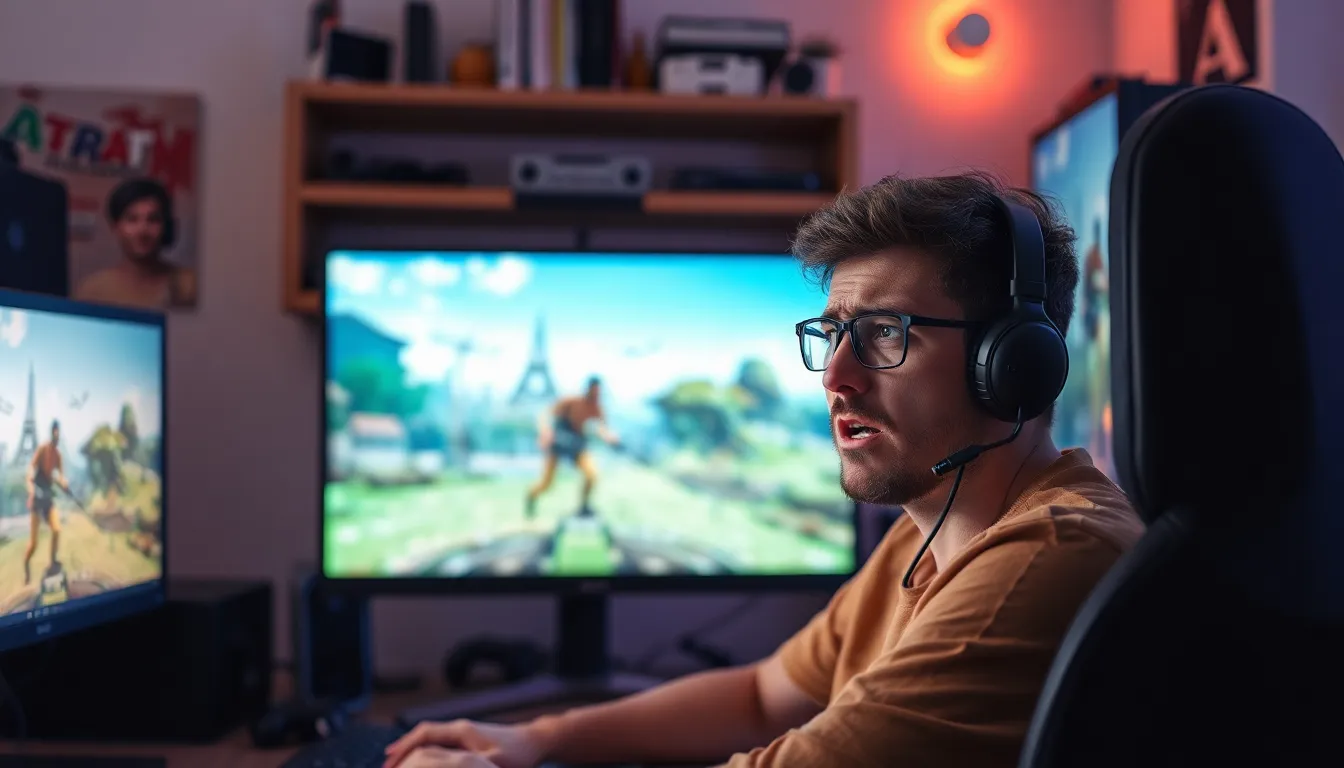In the ever-evolving world of gaming, graphics downgrade controversies have become the hot topic that gets players riled up faster than a cat on a hot tin roof. Picture this: a game trailer that dazzles with breathtaking visuals, only for the final product to look like it was crafted by a toddler with a crayon. It’s enough to make even the calmest gamer throw their controller in disbelief.
These controversies spark debates about honesty in marketing and the expectations set by developers. As players invest their time and money, they expect a product that matches the hype. So, what causes these downgrades? Is it the pressure of deadlines, budget constraints, or just plain old trickery? Buckle up as we dive into the pixelated rabbit hole of graphics downgrades and uncover the truth behind the screens.
Table of Contents
ToggleOverview of Graphics Downgrade Controversies
Graphics downgrade controversies frequently arise in the gaming industry. Players often encounter discrepancies between game trailers and the final products. These situations lead to feelings of disappointment and betrayal among gamers. As trailers highlight impressive visuals, expectations reach high levels, making the final outcome even more jarring when it falls short.
Various factors contribute to graphics downgrades. Tight development deadlines frequently force teams to cut features, including visual quality. Budget constraints may limit resources available for graphics enhancements. Developers occasionally resort to deceptive marketing tactics, which further exacerbate the issue. This results in a cycle of mistrust between consumers and the industry.
Several high-profile cases exemplify these controversies. “Aliens: Colonial Marines,” for instance, showcased a striking demo that differed drastically from the final release. Players criticized the misleading representations. Similarly, “Watch Dogs” faced backlash after its graphics appeared significantly downgraded upon launch. Gamers noted the substantial visual differences between promotional material and gameplay.
The consequences of these downgrades extend beyond disappointment. Companies may suffer reputational damage and financial losses due to public backlash. As players become more vocal, developers continue responding to these issues. Many gaming studios now prioritize transparency, seeking to rebuild trust with their audience. Addressing these controversies remains essential to improving the overall gaming experience.
Notable Cases of Graphics Downgrades

Graphics downgrade controversies highlight significant discrepancies between game trailers and final releases. This section examines notable cases that have sparked widespread discussion.
Case Study: Aliens: Colonial Marines
“Aliens: Colonial Marines” faced severe backlash following its launch in 2013. Promotional materials showcased advanced graphics, creating high expectations. Gamers noted substantial differences between the revealed gameplay footage and the actual product. Critics described the visuals in the final version as muddy and lacking detail. Players invested time and money expecting a polished experience, leading to immense disappointment. Reaction to this discrepancy included a flurry of negative reviews and lost trust in the developer. Ultimately, the game’s reputation suffered significantly, showcasing the repercussions of misleading marketing.
Case Study: Watch Dogs
“Watch Dogs,” released in 2014, generated excitement with its initial reveal. Early gameplay demonstrations presented stunning visuals that captured audience attention. Upon release, players noticed substantial downgrades in graphics quality. Many cited reduced textures and diminished lighting effects in the final game. The divergence between expectations and reality sparked outrage among the gaming community. This realization not only affected player satisfaction but also raised larger questions about marketing integrity. Ubisoft faced scrutiny and commitments to increase transparency in future projects followed.
Impact on Gamers and Developers
Graphics downgrade controversies significantly influence the gaming experience for both players and developers. Gamers frequently express frustration over false advertising from game trailers versus final products. Disappointment arises when stunning visuals promoted prior to release fail to match gameplay. Engagement with gaming communities often reveals strong reactions, varying from outrage to resignation. Many players take to forums and social media to voice these grievances, generating discussions about accountability and transparency.
Gamer Reactions and Opinions
Frustration from gamers stems from feeling misled by marketing tactics. Outrage often circulates online, leading to widespread discussions. Expectations remain high for graphics portrayed in trailers, contributing to disappointment when the final product lacks similar quality. Some players share reviews emphasizing visuals affected by downgrades. Others advocate for transparency in game development processes. Trust erodes when studios fail to meet expectations set by promotional materials. Negative experiences can deter consumers from purchasing future titles from the same developer. Additionally, campaigns demanding accountability often emerge within the community.
Developer Perspectives and Challenges
Developers face numerous challenges when managing graphics quality within tight timelines. Budget constraints limit resources available for visual advancements. High player expectations add pressure to deliver state-of-the-art graphics while adhering to deadlines. Balancing creativity and player satisfaction can feel overwhelming. Many studios strive for transparency but struggle to communicate changes effectively. Realistic timelines sometimes conflict with promotional commitments, resulting in controversy. Some developers recognize the importance of rebuilding trust with consumers through improved communication strategies. Addressing the gap between expectations and reality ultimately remains a priority for the industry.
The Role of Marketing in Graphics Presentations
Marketing plays a crucial role in shaping consumer expectations in the gaming industry. It generates excitement for upcoming titles through trailers showcasing visually stunning gameplay. Developers often create polished graphics to attract attention, leading to heightened anticipation. Yet, when final products do not meet these expectations, disappointment ensues.
Promotional materials can misrepresent technical capabilities or provide a misleading representation of the actual gameplay experience. High-profile controversies like “Aliens: Colonial Marines” and “Watch Dogs” illustrate this issue dramatically. In these cases, initial visuals led gamers to expect high-quality graphics, only to find significant downgrades upon release. These stark discrepancies promote mistrust among players and damage the reputations of development studios.
Targeted marketing strategies often emphasize the most impressive aspects of a game. Developers focus on attracting consumers, sometimes at the cost of transparency. This tactic can create an illusion of superior graphics capabilities, ultimately leading to backlash when the reality falls short. Budgets and development timelines often drive these marketing decisions, considerably affecting graphical fidelity at launch.
Rebuilding trust requires a dedicated effort to improve communication with players. Developers should prioritize transparency in their marketing practices by clearly stating limitations and setting realistic expectations. Openly discussing development challenges helps gamers understand the complexities involved. Emphasizing a commitment to quality over flashy marketing can foster a more loyal consumer base.
Maintaining integrity in marketing practices significantly influences the long-term success of game titles. Addressing graphics downgrade controversies not only affects consumer perception but also impacts future project investments. Trust between developers and gamers can improve by establishing honest and consistent messaging. Such strategies enhance overall gaming experiences and encourage positive interaction within the community.
Graphics downgrade controversies have sparked significant debate within the gaming community. As players demand transparency and honesty from developers, the industry faces pressure to adapt its marketing practices. The gap between promotional materials and final products can lead to disappointment and mistrust, impacting both sales and reputations.
To foster a healthier relationship with consumers, developers must prioritize clear communication about their games’ visual capabilities and development challenges. By focusing on integrity in marketing and delivering on promises, the gaming industry can rebuild trust and enhance the overall experience for players. Ultimately, a commitment to transparency will not only benefit developers but also create a more satisfied and loyal gaming community.




